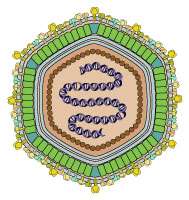Asfarviridae
| Asfarviridae | |
|---|---|
 | |
| Asfarviridae virion | |
| Virus classification | |
| Group: | Group I (dsDNA) |
| Order: | unassigned |
| Family: | Asfarviridae |
| Genera | |
| |
Asfarviridae is a family of double stranded viruses.[1] Asfivirus is the only genus in the family. The related faustoviruses are currently unclassified. Asfiviruses infect insects and swine; faustoviruses infect amoebae.
Asfivirus
The viruses in the genus Asfivirus infect swine, resulting in an onset of African swine fever. The name of this family and genus are derived from the acronym: African swine fever and related viruses. Only a single species has been described to date for this genus.
This group of viruses are the only known arthropod borne DNA viruses. The viruses in this family are all enveloped and have double-stranded DNA genomes.
African swine fever virus exhibits some similarities in genome structure and replication strategies to the poxviruses and phycodnaviruses but has different virion structure from poxviruses and several other properties that distinguish it from the latter.[2][3]
Taxonomy
Group: dsDNA
- Family: Asfarviridae
Virology
The virons consist of an envelope, a capsid, a core and a nucleoprotein complex. They are spherical and measure 175–215 nanometers (nm) in diameter. The capsid is icosahedral (T=189–217) with a diameter of 172–191 nm and appear hexagonal in outline. The capsomers measure 13 nm in diameter and there are 1892–2172 of these per capsid.[2]
The genome is linear double stranded DNA and between 170 and 190 kilobases in length. Its guanine + cytosine content is 39%.
| Genus | Structure | Symmetry | Capsid | Genomic arrangement | Genomic segmentation |
|---|---|---|---|---|---|
| Asfivirus | Spherical Pleomorphic | T=189–217 | Enveloped | Circular | Monopartite |
[4] The virus can be grown in cell culture but cytopathic effects may be absent. Acidophilic, intracytoplasmic inclusion bodies may be visible in biopsies or post mortem material. Replication is cytoplasmic and the virons mature by budding from plasma membrane.
The viruses in this family infect domestic pigs and their relatives. The natural hosts are warthogs (Phacochoerus africanus), bush pigs (Potamochoerus porcus), and argasid ticks (Ornithodoros species). Young warthogs when infected develop a high viraemia and are infectious to ticks. Older warthogs are generally immune to infection. The virus can replicate within the ticks. Transstadial, transovarial and sexual spread within the ticks occurs.
During infection the virions multiply in erythrocytes, endothelial cells and leukocytes and not in the epithelial cells. During infection the virus can be isolated from blood, spleen, visceral lymph nodes and tonsils.
Several species are known, none of which are able to infect humans.
Life cycle
Viral replication is cytoplasmic. Entry into the host cell is achieved by attachment of the viral proteins to host receptors, which mediates endocytosis. Replication follows the DNA strand displacement model. DNA templated transcription is the method of transcription. The virus exits the host cell by microtubular outwards viral transport.[2] Pigs, warthogs, and bushpigs serve as the natural host. The virus is transmitted via a vector (arthropods and ticks). Transmission route: vector.
| Genus | Host details | Tissue tropism | Entry details | Release details | Replication site | Assembly site | Transmission |
|---|---|---|---|---|---|---|---|
| Asfivirus | Pigs; warthogs; bushpigs | Macrophages; Monocytes | Cell receptor endocytosis | Budding | Cytoplasm | Cytoplasm | Ticks |
Epidemiology
This family was originally confined to Africa but has since spread to southern Europe and the Caribbean islands. [2][4]
References
- ↑ Alonso, C; Borca, M; Dixon, L; Revilla, Y; Rodriguez, F; Escribano, JM; Ictv Report, Consortium (May 2018). "ICTV Virus Taxonomy Profile: Asfarviridae". The Journal of General Virology. 99 (5): 613–614. doi:10.1099/jgv.0.001049. PMID 29565243.
- 1 2 3 4 5 "ICTV Online (10th) Report".
- ↑ Index of Viruses—Asfarviridae (2006). In: ICTVdB—The Universal Virus Database, version 4. Büchen-Osmond, C (Ed), Columbia University, New York, USA. https://www.ncbi.nlm.nih.gov/ICTVdb/Ictv/fs_index.htm%5Bpage needed%5D
- 1 2 3 "Viral Zone". ExPASy. Retrieved 12 June 2015.
External links
| Wikimedia Commons has media related to Asfarviridae. |
- ICTV Online (10th) Report: Asfarviridae
- Asfarviridae at the US National Library of Medicine Medical Subject Headings (MeSH)
- ICTVdb
- Viralzone: Asfarviridae